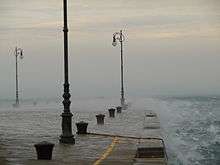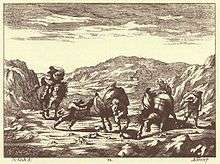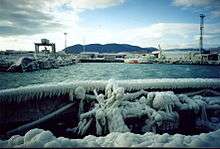Bora (wind)
The bora is a northern to north-eastern katabatic wind in the Adriatic Sea. Similar nomenclature is used for north-eastern winds in other littoral areas of eastern Mediterranean and Black Sea basins.
.jpg)
Name
It is known in Greek as μπόρα (mpóra, pronounced bora) and Italian as bora. In English, the name bora is used.[1][2] The Serbo-Croatian name bura and Slovene burja are not etymologically related to bora; they derive from Common Slavic burja 'storm' (from the verb *burĭti), and the meaning 'bora' developed later.[3]
The same root as bora is found in the name of the Greek mythological figure of Boreas (Βορέας), the North Wind. Historical linguists speculate that the name may derive from a Proto-Indo-European root *gworhx- 'mountain', which gave rise to Germanic burg and berg.[4]
According to Croatian oral legends "Bura" was a beautiful young lady who was thought that she is far prettier than God's fairies. Because of that statement of her God has punished her by prisoned her into deepest pit of mountain Dinara. Every time when some girl thinks that she is beautiful, Bura girl screams so loudly and breaths so deeply what consequently leads to strong and dry wind called "bura".
Features

The changeable bora can often be felt all over Adriatic Croatia, Montenegrin Littoral, the Slovenian Littoral, Trieste, and the rest of the Adriatic east coast. It blows in gusts. The bora is most common during the winter.
It blows hardest when a polar high-pressure area sits over the snow-covered mountains of the interior plateau behind the Dinaric coastal mountain range and a calm low-pressure area lies further south over the warmer Adriatic.[5] As the air grows even colder and thus denser at night, the bora increases. Its initial temperature is so low that even with the warming occasioned by its descent it reaches the lowlands as a cold wind.[6]
The wind takes two different traditional names in areas of Italy depending on associated meteorological conditions: the "light bora" (Italian: bora chiara) is a bora in the presence of clear skies, whereas clouds gathering on the hilltops and moving towards the seaside with rain or snow characterize the "dark bora" (bora scura).
Areas hit


The area where some of the strongest bora winds occur is the Velebit mountain range in Croatia. This seaside mountain chain, spanning 145 kilometers, represents a huge weather and climatic divide between the sharp continental climate of the interior, characterized by significant day/night temperature differences throughout the year, and the Adriatic coast, with a Mediterranean climate. The bora occurs because these two divided masses tend to equalize.
Sailing during the bora can be challenging and it requires caution, regarding readiness of both the boat and its crew. Short, high waves with white crests are its characteristics, making the navigation difficult. The small drops formed by the wind create a so-called "sea smoke" that reduces the visibility significantly. Experienced seamen have a proverb: "When the bora sails, you don't!"[7] Sailing can be extremely dangerous for an inexperienced navigator in the Velebit channel because the wind can start suddenly on a clear and calm day and result in major problems, frequently also affecting road traffic.
Near the towns of Senj, Stara Novalja, Karlobag and the southern portal of the Sveti Rok Tunnel in Croatia, it can reach speeds of up to 220 kilometers per hour. On 21 December 1998 the speed of a gust on the Maslenica Bridge (north of Zadar) was measured at a record speed of 248 kilometres per hour,[8][9] and wind shields were installed.[10] During 22 to 25 December 2003 on A1 highway near Sveti Rok Tunnel a new record was measured at a speed of 304 kilometers per hour.[11]
In February 2012, during the Eastern European Cold Wave, the shoreline in Senj froze and snow piled up after a 150 km/h bora plummeted the temperature to −14 °C, with waves of 7 metres. The bora ripped the trees from the soil and destroyed roofs of houses.[12] On the island of Pag, the Bora threw fish out of the sea. In many Croatian coastal cities, fresh water froze inside the pipes.[13]
The wind is also an integral feature of Slovenia's Vipava Valley and, to a lesser extent, the Karst Plateau (known as Carso in Italian), an area of limestone heights over the Gulf of Trieste stretching towards the Istrian peninsula. Because the region separates the lower Adriatic coast from the Julian Alps range, extreme bora winds often occur there. They have influenced the region's traditional lifestyle and architecture. Towns on the coast, where the bora frequently occurs, are built densely with narrow streets in part because of the wind. Buildings in several towns and villages in Slovenia and the Province of Trieste (Italy) have stones on their roofs to prevent the tiles from being blown off. Chains and ropes are occasionally stretched along the sidewalks in downtown Trieste, Italy, to facilitate pedestrian traffic — gusts in the city are usually above 120 km/h reaching to maxima of near 200 km/h. A strong bora will often be reported on Italian television news. Slovenian towns where the strongest bora occurs are Ajdovščina, Vipava and, to a lesser extent, Nova Gorica. In Slovenia, the most affected section is usually the upper part of the Vipava Valley, stretching from Ajdovščina to Podnanos, where the speed of the wind can exceed 200 km/h.[14]

Strong bora winds also occur in the Tsemes Bay of the Black Sea near the Russian port of Novorossiysk, where they are known as nordost ("northeastern").[15] They can reach speeds of up to 220 kilometres per hour.
References
- "Bora". Merriam-Webster. Retrieved 19 November 2017.
- Stefano Zecchetto; Francesco De Biasio; Marco Bajo (2005). "Features of Scatterometer Wind Observations in the Adriatic Sea". In Fletcher, Caroline A.; Spencer, Tom (eds.). Flooding and Environmental Challenges for Venice and Its Lagoon: State of Knowledge. Cambridge: Cambridge University Press. pp. 53–58.
- Snoj, Marko (2003). Slovenski etimološki slovar (2 ed.). Ljubljana: Modrijan. p. 66. ISBN 961-6465-37-6.
- J. P. Mallory; D. Q. Adams (24 August 2006). The Oxford Introduction to Proto-Indo-European and the Proto-Indo-European World. OUP Oxford. pp. 121–. ISBN 978-0-19-928791-8.
- F. von Wrangel, "Die Ursachen der Bora in Noworossisk", Repertorium für Meteorologie 40 (1876:238-40); the bora of the Karst was described by F. Seidel, "Bermerkungen über die Karstbora", ''M.Z. 8 (1891:232-35), noted by Julius (von) Hann, Handbook of Climatology Robert DeCourcy Ward, tr. (1903): see Petra Seibert, "Hann’s Thermodynamic Foehn In the Adriatic tradition, the bora comes from three mouths: Trieste, Rijeka and Senj. Theory and its Presentation in Meteorological Textbooks in the Course of Time".
- v. Hann 1903.
- "Croatia Wind - Sailing tips - Sailing Europe". SailingEurope.
- A. Bajić, B. Peroš, V. Vučetić, Z. Žibrat, Wind load - a meteorological basis for Croatian standards, GRAĐEVINAR 53 (2001), page 501, (in Croatian); http://hrcak.srce.hr/file/18613
- Radic, Jure; Savor, Zlatko; Puz, Goran (23 March 2018). "Report: Extreme Wind and Salt Influence on Adriatic Bridges". Structural Engineering International. 13 (4): 242–245. doi:10.2749/101686603777964487.
- Sesar, Petar; Krecak, Ana (1 January 2005). "Impact of wind on Croatian highways and bridges". IABSE Symposium Report. 90 (11): 23–29. doi:10.2749/222137805796270469.
- "Pretplati se > Novi list - Online izdanje". novine.novilist.hr.
- "Pogledajte kako je jučer bilo u Senju: Bura nosi sve pred sobom, diže čak i krovove!".
- "Bura izbacuje ribu na obalu, u riječkoj bolnici selili pacijente".
- "Ekipe so v stalni pripravljenosti".
- "A book about bora". Archived from the original on 11 December 2014. Retrieved 6 December 2014.
Further reading
- Hann, Julius. (1903). Handbook of Climatology (Robert DeCourcy Ward, tr.). New York: MacMillan. OCLC 3592809
External links
| Wikisource has the text of the 1911 Encyclopædia Britannica article Bora. |
| Wikimedia Commons has media related to Bora (wind). |